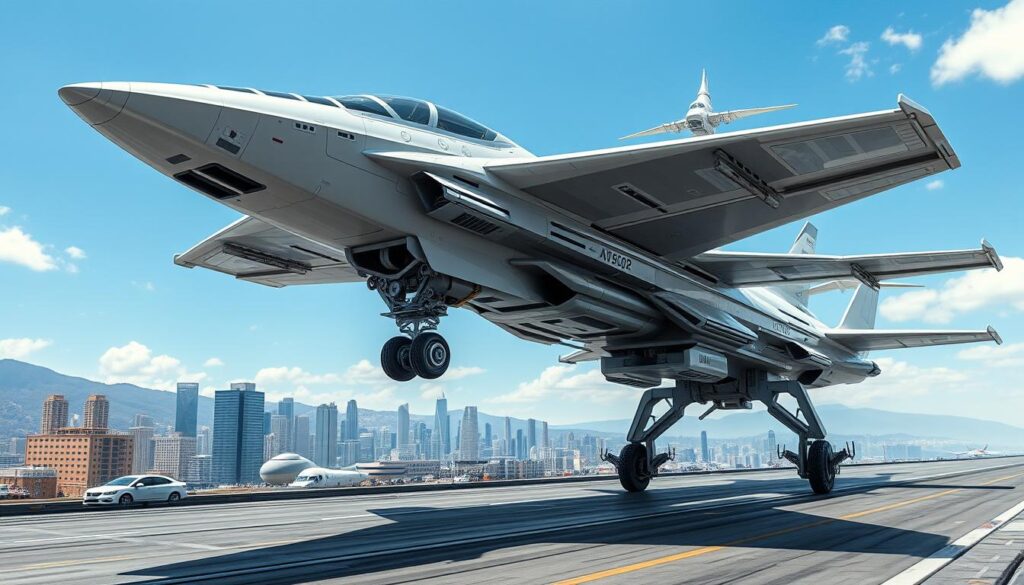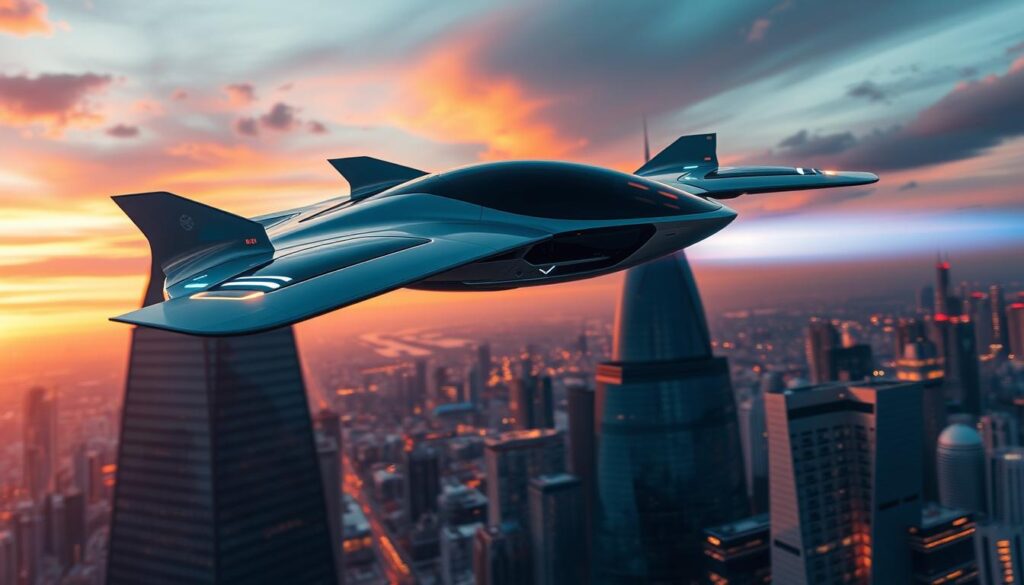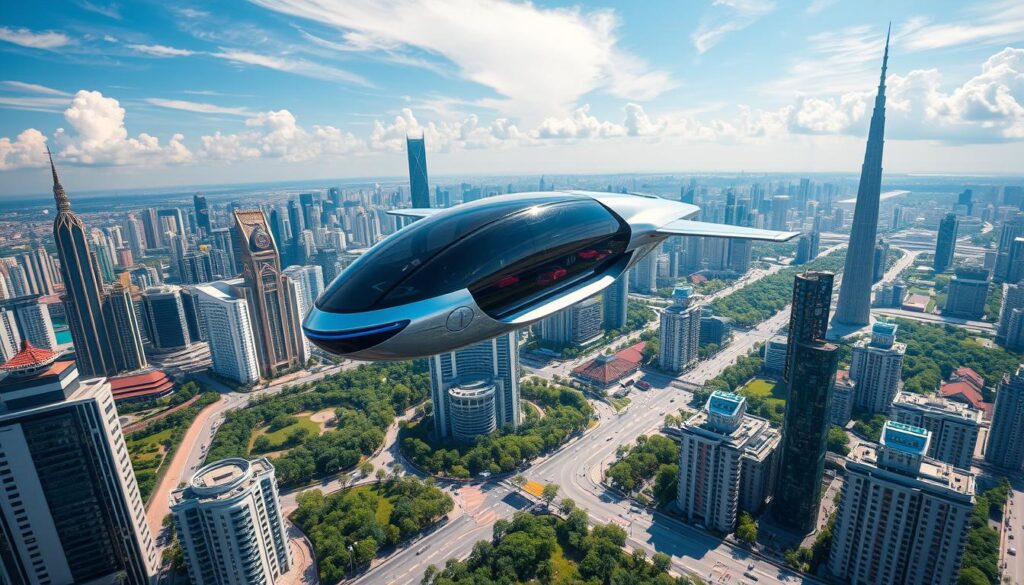China’s flying car innovations are changing how we think about getting around. With Xpeng Aero HT’s Land Aircraft Carrier and eVTOL technology, China is set to change the world. Making flying cars work with our current roads and skies is a big challenge. But China is leading the way, promising a new future for city travel.
I’m excited to dive into flying car tech, thanks to my background in data and AI. China’s flying car push shows its dedication to innovation. The flying car’s high price tag shows it’s a serious investment in our future, marking China’s role in this new tech.
Key Takeaways
- China’s flying car innovations are leading the way in the development of flying car technology, with Xpeng Aero HT’s Land Aircraft Carrier and eVTOL technology at the forefront.
- The integration of flying car technology into existing infrastructure holds great promise for the future of urban mobility, and is a key aspect of China’s flying car innovations.
- The development of flying cars is a testament to China’s commitment to innovation and its determination to stay at the forefront of technological advancements, particularl
- The initial retail price for the flying car is projected to be over 1 million yuan in China, indicating a serious investment in the future of transportation, and a key aspect of China’s flying car innovations.
- The development of flying cars is a testament to China’s commitment to innovation and its determination to stay at the forefront of technological advancements, particularl
- The initial retail price for the flying car is projected to be over 1 million yuan in China, indicating a serious investment in the future of transportation, and a key aspect of China’s flying car innovations.
- The development of flying cars is a testament to China’s commitment to innovation and its determination to stay at the forefront of technological advancements, particularl
- The initial retail price for the flying car is projected to be over 1 million yuan in China, indicating a serious investment in the future of transportation, and a key aspect of China’s flying car innovations.
- The development of flying cars is a testament to China’s commitment to innovation and its determination to stay at the forefront of technological advancements, particularl
- The initial retail price for the flying car is projected to be over 1 million yuan in China, indicating a serious investment in the future of transportation, and a key aspect of China’s flying car innovations.
The Rise of China’s Flying Car Innovations
China is leading the way in flying car technology. Companies like Xpeng Aero HT are making big strides in electric vertical takeoff and landing (eVTOL) tech. This could change how we travel, making it quicker, cleaner, and more efficient.
Xpeng Aero HT is making flying cars easier to use. They’ve made it so you need fewer controls and the car can fly on its own. This is a big step towards making flying cars a reality.
Some key benefits of eVTOL technology include:
- 60% energy savings compared to traditional helicopters
- 90% emission reduction
- 65% noise reduction
These benefits make eVTOL vehicles very appealing. It’s no wonder companies like Xpeng Aero HT are leading this innovation.
Technical Specifications and Design Features
Exploring China’s flying cars, I’m amazed by their innovative designs. The Land Aircraft Carrier stands out, with a six-wheeled EV carrying a two-seater eVTOL aircraft. This design shows a glimpse into the future of personal transportation. It has a range of 1,000 kilometers and can recharge the eVTOL on the move.
The flying car’s specs are impressive too. It can lift off with a 500 kg maximum weight, fly for 20 minutes, and reach 300 meters high. It can go up to 60 km/h on the ground, making it a great choice for personal transportation. The Land Aircraft Carrier can carry 2 people, with a design that’s both strong and light.

The flying car’s design is also noteworthy. It has a multicopter assembly that hides the propellers when driving. It’s powered by 8 propellers and 8 electric motors. Plus, it has a ballistic parachute for safety. As the Land Aircraft Carrier evolves, it will likely change the future of personal transportation.
Performance Analysis and Capabilities
The performance of China’s flying cars is key in their development, focusing on urban mobility. With flying car technology, they aim to change city travel. The AirCar, for instance, turns from car to plane in just 2 minutes and 15 seconds. It’s perfect for those wanting a quick and efficient way to get around.
The AirCar boasts a top speed of 190 km/h, a range of 1000 km, and can stay aloft for over 20 minutes. These features make it great for city travel, allowing users to dodge traffic and fly when needed. As flying car technology evolves, these vehicles will become even more practical for daily use.

| Performance Metric | Value |
|---|---|
| Top Speed | 190 km/h |
| Flight Range | 1000 km |
| Flight Endurance | Over 20 minutes |
As flying car technology keeps improving, we’ll see even better performance in these vehicles. They will play a bigger role in urban mobility solutions.
Safety Systems and Regulatory Compliance
Flying cars are getting closer to reality, and safety is key. Xpeng Aero HT’s eVTOL technology is a big step forward. It aims to make flying safe and easy by using simple controls and automated systems.
China has made history by certifying the world’s first electric flying taxi. This shows China’s commitment to making flying taxis safe and available. The taxi is electric, which means it’s good for the environment and efficient.
Some important features of the Xpeng Aero HT flying car are:
- It can take off and land vertically, making it great for city travel and saving time.
- It uses electric power, which doesn’t pollute, helping China reach its carbon goal.
- It has safety features that protect passengers even if something goes wrong.
These safety features and following rules are essential for flying cars to become common. Xpeng Aero HT is leading the way in making this happen.
Market Impact and Commercial Applications
The Land Aircraft Carrier technology is set to change personal transportation. Companies like Xpeng aim to launch flying cars by 2026. This could lead to a huge demand for these vehicles.
The global market for flying cars is expected to hit $1.5 trillion by 2040. Experts think flying cars could cut down on traffic in cities. This could make city travel much easier.
Flying cars will have many uses, from getting people around to helping in emergencies. But, we need air traffic rules and safety standards first. This shows there are challenges ahead.
Yet, with eVTOL technology and hybrid systems, flying cars are becoming a reality.
Some key features of flying cars include:
- Collision detection
- Autonomous navigation
- Real-time weather analysis
The flying car market is growing fast. It will create many jobs and make travel faster. By 2035, over 300,000 jobs will be made in engineering and more.
Research shows flying cars could cut travel time in cities by up to 40%. This is exciting news for city dwellers.
| Year | Projected Number of Flying Cars | Market Value |
|---|---|---|
| 2025 | 10,000 | $10 billion |
| 2030 | 5 million | $500 billion |
| 2040 | 10 million | $1.5 trillion |
Future Development Roadmap
China’s Flying Car Innovations are moving fast. Technological advancements and plans to expand globally will guide the future. Companies like Xpeng Aeroht are pushing to make flying cars available to everyone.
The flying car industry in China could change how we travel. The government wants to test electric flying cars in six major cities. This move could make flying cars a big deal worldwide.
Upcoming Models and Prototypes
Chinese companies like Xpeng Aeroht and EHang are working on new flying cars. These will have advanced technology, making flying easy and safe. They aim to launch these models soon.
Planned Technological Improvements
China plans to make flying cars better and greener. They want to create quieter and more efficient flying cars. This will help make flying cars a sustainable option for the future.
International Expansion Strategy
China’s flying car industry is looking to grow globally. Companies are eyeing markets in the United States and Japan. They aim to partner with local businesses to expand their reach.
Conclusion: Reshaping the Future of Personal Transportation
China is leading the way in flying car technology, including eVTOL technology and models like the Land Aircraft Carrier. These innovations are set to change urban mobility and personal transportation forever. Companies like Joby Aviation, AeroMobil, and Volocopter are making big strides, promising a huge impact on how we travel.
Chinese companies EHANG and Xpeng Aero HT are also making waves in this field. Their flying cars can fly fast and carry people smoothly. This could make our cities more efficient and less crowded, and better for the environment.
Even though there are challenges ahead, like rules and infrastructure, Chinese innovators are not giving up. They are working hard to make flying cars a reality. As we wrap up this look at China’s flying car progress, one thing is clear: the future of travel is about to get a lot more exciting, and China is at the forefront.



